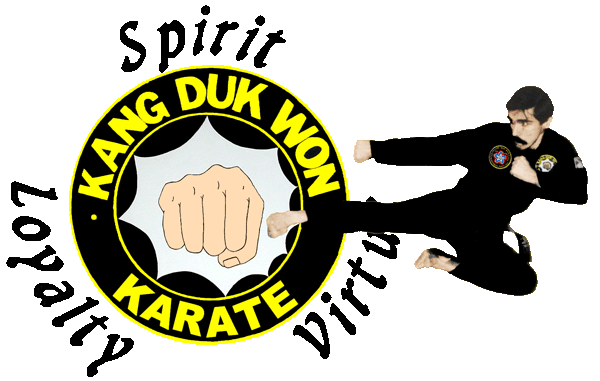
 |
AMERICAN KANG DUK WON KARATE |
Presented by:
|

|

Times will vary (30 - 45 MINUTES). Maintain a relaxed pace and allow adequate time for meditation / relaxation while at the center. Each movement entering and departing should be controlled, focused, and done in silence. Allow your other senses (sight, hearing, smell, touch) to be heightened throughout each stage of the exercise. At the conclusion of the walk of the labyrinth, you should experience a sense of being centered, having a strong ki flow, and conscious of a clear and relaxed mental state.
A labyrinth is a single path tool for personal, psychological and spiritual transformation. It is a structure containing an intricate network of winding passages hard to follow without losing one's way. The true labyrinth has no false pathways or dead ends to confuse those who follow its winding course. The mouth is where you enter. You walk on the paths or circuits. The walls keep you on the path. The goal is in the middle of the labyrinth. When you reach it, you have gone half the way. You need to turn around and walk out.
Mosaics from the Roman Empire often depicted labyrinths as strongholds or fortified cities.
Throughout the world there exists a symbol - a series of concentric lines, carefully connected. This symbol, and its family of derivatives, has been traced back over 3500 years; it occurs in different cultures, at different points in time, in places as diverse as Peru, Arizona, Iceland, Scandinavia, Crete, Egypt, India and Sumatra. The lines of contact between these widely spaced bursts of labyrinth are difficult to trace, and its origins remain mysterious.
One such exercise is initiating and completing a labyrinth walk. A labyrinth is a walking meditation... a spiritual tool for reconnecting with your inner voice (Ki). Walking these single path designs assists us with bringing together the analytical/rational part of our consciousness with the Intuitive/Spiritual level of consciousness. “It is an exercise for the mind, body, and spirit.”
Other ancient labyrinths date back to early Egypt, Peru, India, and even the Native American nations of the Southwest. The labyrinths were used for ritual walking and spiritual contemplation. Often called “city of turns” labyrinths were equated with Holy cities such as Troy, Jericho, and Jerusalem. Labyrinths have been potent symbols in many cultures for thousands of years.
The early Greek circuit was known as the labyrinth of the Cretan Minotaur. In mythology, the engineering genius Daedalus is credited with having contrived the labyrinthine floor in Cnossus as a dancing floor for the king Minos' daughter Ariadne.
The thread that was used to find the way out is a metaphor for the silken thread produced by the spider. Within the confines of the labyrinth, the minotaur (a creature part bull - part human) was held as a means of humiliating King Minos. Poseidon (god of the sea) sent this horrible step-son to Minos because he had failed to make a fitting sacrifice to the powerful sea god. In a subsequent Greek myth the hero Theseus finally killed the Minotaur. Theseus defeated the beast at the heart of darkness - and created a myth that is still vibrant and captivating some 3000 years later.
Be aware that a labyrinth is different than a maze. A maze is made up of dead-ends, false pathways, traps. A labyrinth, on the other hand, has one path - to the center, and then back out again, transformed.
The spiral pattern is the most generative form of subtle energy. When its coil is unwound the stored energy is released. Circles (circular motion) are rich in both yin and yang (yin underground water crossing yang energy lines). The labyrinth resonates to this numinous (magical power) spiral, the Phi ratio known as the 'Golden Mean' (the most pleasing shape, it is incoporated into many aspects of art) found in all of nature. In the martial arts it is referred to as ki, chi, or our life force.
Equated with the brain many cultures believed that the labyrinth could cure illness. Today the labyrinth is known to have a curative effect on certain ailments by producing a sense of well-being and balance through a type of vestibular (passage between) stimulation, accessing both left and right hemispheres of the brain.
Remember Theseus? Using the golden thread, he was able to emerge from the Labyrinth after slaying the Minotaur. The thread led him back to the one he loved. All journeys are ultimately through a labyrinth, though mostly this is metaphoric. The golden thread is the truth of our spirits. If we follow it with trust, we will emerge; re-surface from the depths of uncertainty, weakness, and the most difficult challenges.
| Consider the symbolism of the American Kang Duk Won emblem! (The fist enters from darkness into light (awareness, knowledge)). |
 |
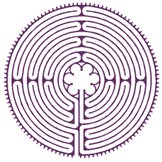
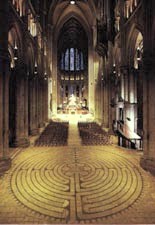
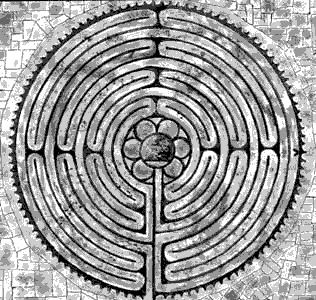
The pilgrim would progress shoeless up the nave (entrance) to the labyrinth, a structure 13 m (42.5 ft.) across and set out in the flagstones of the floor. Dancing around and around until reaching the center, a ritual commonly seen at each of the four annual fairs, the pilgrim became more and more sensitive to the power accumulated in the vast cathedral chamber (music, stained glass, architectural design).
Moving to the middle point, the pilgrim was supposed to receive the full force from the luminous light emanating from the three stained glass rose windows. If the pilgrim experienced the entire sensuousness of the cathedral, it would be because the body's senses had apprehended all the musical and geometrical proportions, and all the numbers and lines expressed in the building's interior.
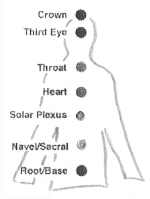 |
The seven-circuit labyrinth can be approached as a means to improve the health of the body and mind. The walk should be an active-meditation exercise. Each circuit would be directly related to the seven circuits of the anatomy (left). As you walk the labyrinth, focus on sending positive ki through your body and center specifically on the crown, third eye (inner being), throat, heart, solar plexus, navel, and base (ki spot). |

Several pictures taken during the construction are given below.
|
stake near the wheelbarrow, and measuring the radius. |

|

|
Power tools are gratefully appreciated. |
|
the center of the labyrinth is laid with stone, the outer perimeter is marked with a stone ring, and the workers gather to appreciate their accomplishments. |
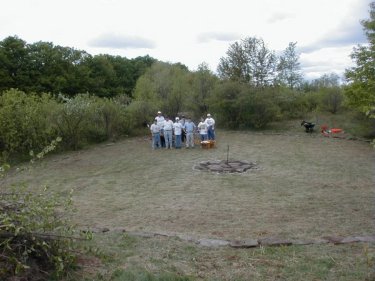
|

|
|
 |
|
|
|
|
|
|

|
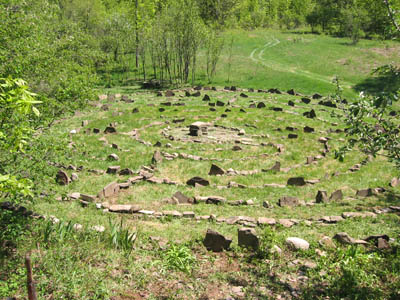
|
|
Golden Ratio
http://ilc.tsms.soton.ac.uk/caerdroia/f_intro.htm
http://www.labyrinthsociety.org/links.html
http://www.concentric.net/%7EEgreen/prof/otherstudies/labyrinth.html
http://www.gwydir.demon.co.uk/jo/maze/index.htm
http://www.surrendertotheheart.com/
http://artpaver.com/labmain.htm
http://labyrinth.kumu.org/
http://mandalaproject.org
http://www1.pitt.edu/~medart/menufrance/chartres/charmain.html
Return to Black Belt Training Articles
